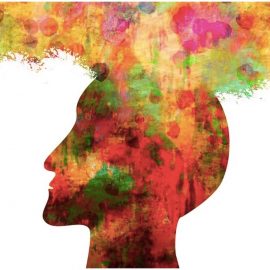

This article is an excerpt from the Shortform book guide to "Come As You Are" by Emily Nagoski. Shortform has the world's best summaries and analyses of books you should be reading.
Like this article? Sign up for a free trial here .
Is Emily Nagoski’s book Come as You Are worth reading? How does modern culture repress female sexuality?
Come As You Are by Emily Nagoski explores women’s sexuality using scientific research and the author’s years of experience as a sex educator. Nagoski decided to write the book to change the negative way that many women talk, think, and feel about themselves due to harmful cultural messaging that encourages self-criticism and perpetuates misinformation about what constitutes “normal” sexuality.
Here is our review of Come as You Are by Emily Nagoski.
About the Author
Emily Nagoski is an award-winning author, researcher, educator, and activist who specializes in women’s sexuality. She began her career as a sex educator as an undergraduate at the University of Delaware, where she educated her peers about health-related topics such as nutrition, physical activity, and sex.
Nagoski’s experience working with her peers inspired her to pursue a career in sex education. She went on to earn an M.S. in Counseling Psychology and a Ph.D. in Health Behavior at Indiana University. While earning her degrees, she worked as an intern at the renowned Kinsey Institute for Research in Sex, Gender, and Reproduction and learned from some of the greatest experts in her field. She also taught classes in human sexuality, relationships, communication, stress management, and sex education.
In addition to her educational background, Nagoski is also trained in Gottman’s Seven Principles for relationship success, bystander intervention, motivational interviewing, and cultural inclusivity.
Following her graduate education, Nagoski worked for eight years as a lecturer and Director of Wellness Education at Smith College before deciding to pursue a full-time career in writing and speaking. Now, she travels the world teaching professionals, college students, and the general public about the science of sex and relationships through a variety of talks, programs, and training courses. She lectures at venues ranging from research conferences and universities to bookstores and sex toy stores.
Connect with Emily Nagoski:
The Book’s Publication
Publisher: Simon and Schuster
Come As You Are was originally published in 2015 and was Nagoski’s first book. It became a New York Times bestseller and won several awards, including the Society for Sex Therapy and Research’s 2017 Consumer Book Award and a Goodreads Choice Award for Top 5 Science and Technology Books. In 2021, Nagoski revised and updated the book with the latest science and perspectives on sexuality, and she also narrated and released an audiobook version. We reference the revised and updated version in this guide.
After the publication of Come As You Are, Nagoski authored several other publications on female health, including Burnout: The Secret to Unlocking the Stress Cycle, which she wrote with her twin sister, Amelia Nagoski.
Historical Context
Come As You Are’s publication coincided with several relevant cultural factors that set the stage for the book’s impact. In particular, the book was published amidst growing research exploring the negative effects of social media on self-esteem and body image, the rise of the Me Too movement against sexual abuse and harassment, and heightened tension surrounding the abortion debate and the female “my body, my choice” narrative.
These factors contributed to a cultural discourse surrounding standards for women’s beauty, sexuality, and health that left women feeling particularly targeted and misunderstood. Although society had finally begun to address these women-centered issues, the judgment underlying the conversations made women feel as if their voices were still going unheard.
For example, despite research acknowledging the psychological harm of social media, women continued to feel surrounded by content targeting their self-esteem. Similarly, although more women were coming forward with reports of sexual abuse, they faced accusations of lying and attention-seeking. Likewise, as many women argued for the right to make choices about their bodies during pregnancy, they felt as if society placed little value on their lives due to pro-life opponents’ argument that we should prioritize the life of the fetus above all else.
Through this contextual lens, it becomes clear why Nagoski’s book was so influential. Not only did it provide a wealth of information on women’s anatomy, female sexuality, and the negative effects of culture on women’s well-being that was relevant to the current issues of the time, but it also empowered women by giving them access to clear and factual information that validated their experience.
Intellectual Context
The ideas presented in Come As You Are are primarily based on current scientific research in fields like anatomy, physiology, psychology, gender studies, and media studies. The author also relies heavily on her own experiences as a sex educator, which she describes to add relatability and context to the information provided by the research.
Although Come As You Are wasn’t the first book of the 21st century to explore women’s sexuality, it was by far the most comprehensive, covering everything from the development of anatomy to the experience of orgasm. It was also unique in its exploration of the ways culture affects our beliefs about sexuality.
As a point of comparison, Ian Kerner’s She Comes First, released in 2009, discusses female sexuality from a more narrow perspective. Specifically, it focuses only on women’s arousal and pleasure, primarily advocating for the use of oral sex to make women reach orgasm. What’s more, a man wrote the book and targeted it toward men, which speaks to the historical trend of viewing women’s sexuality through the scope of men’s. In contrast, Nagoski speaks broadly about women’s sexuality as a woman and directly to women, which adds relatability and authenticity that Kurner’s book lacks.
The Book’s Impact
Come As You Are was revolutionary in its genre due to its thorough and science-backed exploration of women’s sexuality. What’s more, its supportive, easy-to-read nature made the compilation of years of scientific research on women’s sexuality easily accessible to women across the globe.
The scale of the book’s impact is evident in the sharp increase of publications related to women’s sexuality that followed from its success. Other female authors followed in Nagoski’s footsteps by either expanding on or deepening her ideas. Some examples include:
- The Vagina Bible by Dr. Jen Gunter, which calls on science to dispel common myths about the vagina
- All the Fucking Mistakes by Gigi Engle, which dives deeper into how culture has made women ashamed of their sexuality and how they can take their power back
- The Pleasure Gap by Katherine Rowland, which uses interviews with women and healthcare professionals as the basis for a discussion on inequality in the bedroom and the specific effect of culture on women’s sexual desire
Critical Reception
Emily Nagoski’s Come As You Are reviews were largely positive. In particular, field experts such as John Gottman and Carol Queen praised the book, stressing the impact of the book as an insightful source of information for anyone looking to learn about sex.
Positive reviews of the book highlight its credibility and educational value, with many suggesting that anyone and everyone should read it due to its thoroughness and research-based perspective. They also spotlight the author’s fun and accessible writing style, which they say makes it a pleasurable and easy read.
On the other hand, negative reviews criticize the writing style, stating that it’s condescending. They also complain that the book contains too much fluff and not enough actionables. Additionally, some reviews criticize the author for being liberal-slanting and biased toward those who experience less sexual desire because her discussion focuses on their sexual needs.
Commentary on the Book’s Approach
Nagoski’s approach in this book is overall thorough, logical, and easy to follow. Each chapter of Come As You Are begins with an anecdote from the author’s personal experience as a sex educator. Each anecdote centers on one of several couples whose stories demonstrate various aspects of our sexual experience.
Following the anecdote, the author introduces the main idea of the chapter, accompanied by a roadmap that guides the reader through the idea’s main principles. The body of the chapter then explores the main idea from a scientific perspective, citing research and utilizing examples and diagrams (when appropriate) that serve to make the science as accessible as possible to the reader. The author also uses a fun and conversational tone to add relatability.
In several instances, the author provides practical tools to apply the ideas introduced in the chapter. In Chapter 2, for example, she includes self-evaluation scales to help readers reflect on their sexual response.
Despite being largely straightforward, the book contains a few instances in which Nagoski tries to increase understanding through the use of a metaphor or example but doesn’t explain it thoroughly enough to be helpful. For instance, in Chapter 4, the author suggests that the key to managing stress and attachment in a committed relationship is having “sex that advances the plot.” Unfortunately, the explanation that follows this idea doesn’t adequately inform readers about how to apply the principle—they’re left without actionables or a clear understanding of what “sex that advances the plot” actually entails.
Commentary on the Book’s Organization
Nagoski divides the book’s nine chapters among four parts that progress from the most basic aspects of sexuality to the most complex. The first part talks about sexuality from a scientific perspective, focusing on anatomy and the brain mechanisms responsible for sexual response and context. The second part discusses the emotional and cultural factors that interact with our internal mechanisms to influence our sexual experience. The third part dives deeper into the concepts of arousal and desire, which are some of the most largely misunderstood aspects of female sexuality. Finally, the fourth part talks about sexual pleasure and how to cultivate confidence and joy in yourself.
This organization is hierarchical in that ideas introduced in the first chapters are essential to understanding the ideas in later chapters. It also moves from concrete ideas to more abstract ones. The benefit of this approach is that it’s logical and easy for the reader to follow—each idea leads neatly to the next. On the other hand, because so many of the ideas interconnect, even with the hierarchical organization, there are times when the reader can’t fully understand certain ideas until they’re explained in more detail in later chapters. For example, desire is first mentioned in Chapter 2 when exploring models of sexual response, but it isn’t until Chapter 7 that we thoroughly understand how the mechanism of desire works.

———End of Preview———
Like what you just read? Read the rest of the world's best book summary and analysis of Emily Nagoski's "Come As You Are" at Shortform .
Here's what you'll find in our full Come As You Are summary :
- Why women should change the way they talk, think, and feel about their sexuality
- A look at the misinformation and harmful cultural messaging surrounding sex
- A discussion around the individual experiences of arousal, desire, and orgasm






